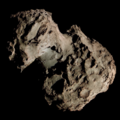Comet Urata-Niijima is a periodic comet in the Solar System discovered by Japanese astronomers Tsuneo Niijima and Takeshi Urata on October 30, 1986, at Ojima, the first orbit was calculated by Brian G. Marsden on November 5 giving an orbital period of 6.42 years.
On October 20, 1993, the comet was recovered by J. V. Scotti (Spacewatch, Kitt Peak Observatory, Arizona, United States), and on the next return on March 4, 2000, by Philippe. L. Lamy and Harold. A. Weaver using the Hubble Space Telescope.
The nucleus of the comet has a radius of 0.90 ± 0.05 kilometers, assuming a geometric albedo of 0.04.[4]
References
- ^ "112P/Urata-Niijima Orbit". Minor Planet Center. Retrieved 2014-06-17.
- ^ Syuichi Nakano (2010-04-08). "112P/Urata-Niijima (NK 1906)". OAA Computing and Minor Planet Sections. Retrieved 2012-02-24.
- ^ "Horizons Batch for 112P/Urata–Niijima (90000986) on 2026-Sep-21" (Perihelion occurs when rdot flips from negative to positive). JPL Horizons. Retrieved 2023-07-06. (JPL#35 Soln.date: 2021-Sep-20)
- ^ Lamy, P. L.; Toth, I.; Weaver, H. A.; A'Hearn, M. F.; Jorda, L. (December 2009). "Properties of the nuclei and comae of 13 ecliptic comets from Hubble Space Telescope snapshot observations". Astronomy & Astrophysics. 508 (2): 1045–1056. Bibcode:2009A&A...508.1045L. doi:10.1051/0004-6361/200811462. S2CID 125249770.
External links
- Orbital simulation from JPL (Java) / Horizons Ephemeris
- 112P at Kronk's Cometography
- 112P at Kazuo Kinoshita's Comets
- 112P at Seiichi Yoshida's Comet Catalog











You must be logged in to post a comment.